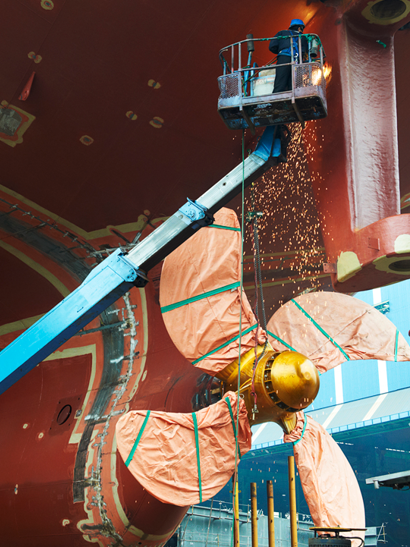Until recently, world orderbooks might have been at unusually low levels but this has changed dramatically in recent months across various sectors, says Nikos Tsatsaros, LR’s New Construction Director. Following record contracting in the container ship segment in 2020/2021 and an uplift on pure car and truck carrier (PCTC) orders in 2023, the LNG carrier tally now stands at a record and there has been a flurry of new very large crude carrier (VLCC) contracting in recent months.
After years of low newbuild ordering, several years of elevated tanker tonne-mile demand have caused sustained high earnings, and an uptick in tanker ordering since the start of 2023. In 2023, both product and chemical tankers experienced their highest ordering levels since 2015 – an activity supported by slot availability for smaller vessels. Crude tanker ordering only picked up towards the end of 2023, with momentum continuing into 2024 Q1. The growth in global oil demand is expected to remain positive through the 2020s. The tanker fleet is ageing and needs replacement. Some 32% of the current oil tanker fleet is over 15 years old. This share is expected to rise to over 50% in the next ten years, despite the current boost in the tanker orderbook. Experts believe that at least one more generation of crude tankers will be required, and maybe even more.
A mild Northern Hemisphere winter plus Europe adjusting to the loss of Russian pipeline gas imports has led to a drop in global LNG trading and prices. LNG carrier earnings are expected to drop due to additional capacity resulting from newbuild vessel deliveries. Falling utilisation is expected to be only partially offset by increases in tonne-mile trade, caused by market disruptors such as the Panama Canal restrictions and the Red Sea crisis. Newbuild demand is also likely to be boosted by the need to replace older vessels.
Currently 49 ships in the LNG fleet are over 25 years of age. These older vessels are likely to be scrapped or converted if and when earnings drop to a sufficiently low level. Vessel replacements account for 2/3rds of all newbuild orders towards the end of the forecast in 2030. Many older and steam turbine LNG carriers (30% of the fleet) may be converted to Floating Storage Regasification Units (FSRUs).
No more ‘business as usual’
However, Tsatsaros believes that prudent shipowners should be assessing their newbuilding strategies. The specs of ships designed for operation over the next two decades and beyond requires careful consideration, he says, as he predicts the development of some completely new ship types, some which are already evolving, such as very large ammonia carriers (VLACs) and liquid carbon dioxide (LCO₂) Carriers.
In the first instance, however, Tsatsaros identifies one key issue faced universally by owners preparing to place new ship contracts. Where to build?
Many Chinese yards have record orderbooks and the Government has placed strict controls on shipbuilding expansion in the years ahead – no more green-field yards will be permitted, and expansions of existing facilities will face close scrutiny. Meanwhile, recent contracting activity has filled up builders elsewhere in Asia and, he says, this could cause a potential bottleneck over the next few years.
However, there has been some consolidation in other areas, for example the Philippines and Subic Shipyard, and we will also soon see a newcomer in the industry; International Maritime Industries (IMI) – a joint venture between Saudi Aramco, Bahri, HHI and Lamprell – has the ambition to create a surge in the shipbuilding orderbooks with capabilities varying from oil rigs to VLCCs and ship repairs/retrofits.
Prices that have already risen sharply over the last 12 months are set to rise further, he predicts. The current tanker and bulker fleet is aged and to a certain extend non-compliant. There is a need to renew a large proportion of this fleet and these segments are the bread and butter of Chinese shipbuilders. There is no reason why shipbuilders would reduce their prices under the current market conditions.

Adapting the fleet
The retrofitting of existing vessels could alleviate the situation to some extent. Modifying engines for new low- or zero-emission fuels is likely to offer the biggest benefits, once engine retrofits are available at scale. The outcome of such moves will not only raise ships’ sustainability criteria and increase their marketability to ESG-aware charterers, but also, in practical terms, yield significant financial benefits through lower carbon taxes, at least in Europe.
However, fuel modifications are expensive, and the marine propulsion sector is concentrated in the hands of just a few major corporations. Their main priority is the development of new engines running on sustainable fuels, although the retrofit market constitutes a significant component of their business operations.
Meanwhile the range of energy saving devices (ESD) continues to widen. ESDs offer significant potential to raise the efficiency of existing vessels and improve their carbon intensity indicator (CII) ratings. For shipowners whose vessels trade within, to, or from, the European Economic Area, ESDs will translate into dollar savings when shipping companies have to surrender EU allowances covering their ships’ carbon emissions by the end of September 2025 at the latest.
Energy saving technologies and On Shore Power Supply (OPS) uptake has grown 21% y-o-y, with more than 4/5ths of the installations happening during the new construction phase. Installations on in-service ships have grown 5x since 2018. In 2023, some 2000 installations of these technologies occurred. Propellers and high-voltage energy converters – HVECs – represent more than 95% of the total installations and have grown 5 x since 2018, with bulk carriers and container ships responsible for 50% and 20% of the installations respectively. Less than 4% of the activity is associated with hull and wind-related energy saving technologies.
There is a high concentration of HVEC retrofits in Chinese bulk carriers that is likely to be related to upcoming local regulations. 440 retrofit events occurred in Chinese classed, owned and flagged vessels. 435 installations were HVEC retrofits, of which 341 were in bulk carriers. If we exclude the Chinese flagged vessels, the number of retrofits drops from 1,638 to 1,198. Upcoming regulations and incentives for shore power connections from China’s Ministry of Transportation might be linked to this wave of retrofitting activity and potentially linked with bulk carriers' relatively low uptake of alternative fuels.

A new generation
Tsatsaros also notes that shipping’s energy transition is already generating demand for entirely new ship types, the first of which are already under construction. He points to the first LCO₂ carriers, four of which are currently under construction at Dalian Shipbuilding in China. The first two LCO₂s, launched early in April, are due for delivery later this year to Northern Lights, a joint venture between Equinor, Shell, and TotalEnergies.
The 7,500m3 vessels, powered by LNG and fitted with wind-assisted technology and air lubrication, are expected to have a carbon footprint 34% less than similar gas carriers running on conventional fuel. They will load carbon dioxide captured at industrial facilities and ship it to a terminal in Øygarden, Norway, before the gas in injected into a permanent storage site under the North Sea.
Meanwhile, Greece’s Capital Gas Ship Management Corp is the first shipowning group to make a move in the LCO₂ carrier sector. The company’s four 22,000m3 vessels under construction at Hyundai Mipo Dockyard will carry the gas at -55°C and will also be capable of transporting ammonia and LPG. The ships have been designed ready for LNG and other propulsion fuels, as well as ready for carbon capture and cold ironing.
Tsatsaros also identifies VLACs as another new sector. Ammonia, a hydrogen derivative, is regarded as a far simpler means of transporting hydrogen that is regarded by many as the ultimate ‘green’ fuel of the future.
A number of vessels have been ordered and other contracts are understood to be under discussion. The vessels, ranging in size between 70,000m3 and 93,000m3, are on order at shipbuilders including Hyundai Samho Heavy Industries and Hanwha Ocean, formerly known as Daewoo Shipbuilding & Marine Engineering in South Korea, and Jiangnan Shipyard in China.
Future outlook
Ship recycling remains at historic low levels. Market disruptors (Russia/Ukraine war, Panama Canal restrictions and the Red Sea crisis) are playing havoc with tonne mile activity, causing exceptional rates in several segments. These high rates are discouraging owners from scrapping vessels – causing the expected surge in scrapping to be pushed to the side. This in turn, has a negative impact on the newbuilding forecast, as around 65% of all vessel newbuilding in the 2024-2028 period is associated with the replacement of scrapped tonnage.
Finally, the adoption of new environmentally friendly technologies in association with an increase in the maturity of the alternative fuels is slowly but gradually increasing as more governments declare their commitment to investing in port and bunkering infrastructure.
Developing a strategy that will combine the retrofit of existing assets along with newbuild orders with deliveries in 2028 onward will potentially support shipowners with their medium/long term business plans and fleet regulatory compliance.








